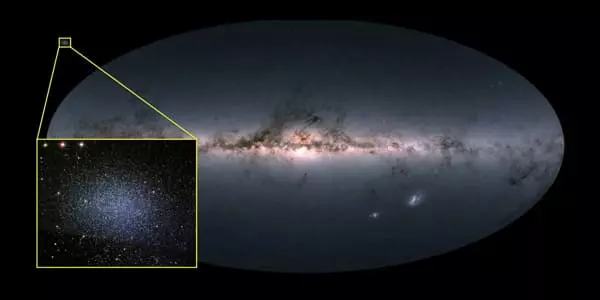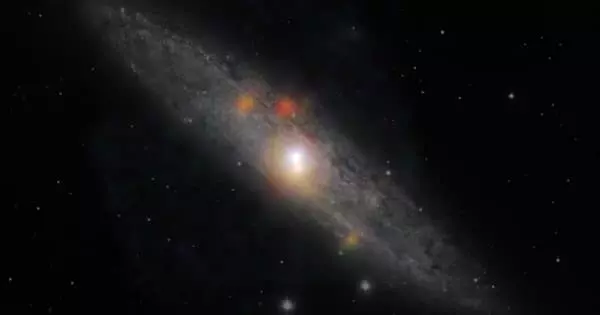A Surprisingly Massive Black Hole Has Been Discovered in a Milky Way Satellite Galaxy. Astronomers at The University of Texas at Austin’s McDonald Observatory discovered an unusually massive black hole at the heart of Leo I, one of the Milky Way’s dwarf satellite galaxies.
Astronomers at The University of Texas at Austin’s McDonald Observatory discovered an unusually massive black hole at the heart of Leo I, one of the Milky Way’s dwarf satellite galaxies. The discovery, which is almost as massive as our own galaxy’s black hole, has the potential to change our understanding of how all galaxies the building blocks of the universe evolve. The research was published in the most recent issue of The Astrophysical Journal.
Because of its uniqueness, the team decided to investigate Leo I. Leo I, unlike most dwarf galaxies orbiting the Milky Way, lacks dark matter. Researchers measured Leo I’s dark matter profile, or how the density of dark matter changes from the galaxy’s outskirts to its core. They accomplished this by calculating its gravitational pull on the stars: the faster the stars move, the more matter is enclosed in their orbits. The team was particularly interested in whether the density of dark matter increases toward the galaxy’s center. They also wanted to know if their profile measurement would be consistent with previous ones made using older telescope data combined with computer models.
The models are screaming that you need a black hole at the center; you don’t really need a lot of dark matter. You have a very small galaxy collapsing into the Milky Way, and its black hole is roughly the size of the Milky Way’s. The mass-to-volume ratio is absolutely massive. The Milky Way is dominant, but the Leo I black hole is nearly comparable.
Karl Gebhardt
The team is led by Mara José Bustamante, a recent UT Austin doctoral graduate, and includes UT astronomers Eva Noyola, Karl Gebhardt, and Greg Zeimann, as well as colleagues from Germany’s Max Planck Institute for Extraterrestrial Physics (MPE).
They made their observations using a one-of-a-kind instrument called VIRUS-W on McDonald Observatory’s 2.7-meter Harlan J. Smith Telescope. When the team fed their improved data and sophisticated models into a supercomputer at the University of Texas at Austin’s Texas Advanced Computing Center, they got an unexpected result.
Cygnus X-1, located within the Milky Way in the constellation of Cygnus, the Swan, was the first black hole discovered. In 1964, astronomers detected the first signs of a black hole by observing gas sucked away from a closely orbiting blue supergiant star.

“The models are screaming that you need a black hole at the center; you don’t really need a lot of dark matter,” Gebhardt said. “You have a very small galaxy collapsing into the Milky Way, and its black hole is roughly the size of the Milky Way’s. The mass-to-volume ratio is absolutely massive. The Milky Way is dominant, but the Leo I black hole is nearly comparable.” The end result is unprecedented.
The researchers stated that the results differed from previous Leo I studies due to a combination of improved data and supercomputer simulations. Previous studies focused on the velocities of individual stars, leaving the central, dense region of the galaxy mostly unexplored. The current study found a bias toward low velocities for the few velocities taken in the past. This, in turn, decreased the inferred amount of matter enclosed within their orbits.
The new data is concentrated in the center and thus unaffected by this bias. The amount of inferred matter contained within the stars’ orbits increased dramatically. The discovery could upend astronomers’ understanding of galaxy evolution because “there is no explanation for this kind of black hole in dwarf spheroidal galaxies,” according to Bustamante.
The discovery is all the more significant because astronomers have spent the last 20 years studying galaxies like Leo I, also known as “dwarf spheroidal galaxies,” to better understand how dark matter is distributed within galaxies, according to Gebhardt. This new type of black hole merger also provides a new signal for gravitational wave observatories to look for.
“If Leo I’s black hole has a high mass, it may explain how black holes grow in massive galaxies,” Gebhardt said. That’s because, as small galaxies like Leo I collide with larger galaxies, the smaller galaxy’s black hole merges with the larger galaxy’s, increasing the larger galaxy’s mass.
VIRUS-W, developed by a team at MPE in Germany, is the world’s only instrument capable of performing this type of dark matter profile study. Noyola pointed out that many dwarf galaxies in the southern hemisphere are good targets for it, but no southern hemisphere telescope is equipped for it. The Giant Magellan Telescope (GMT), which is currently being built in Chile, was designed in part for this type of work. The GMT was founded by the University of Texas at Austin.





